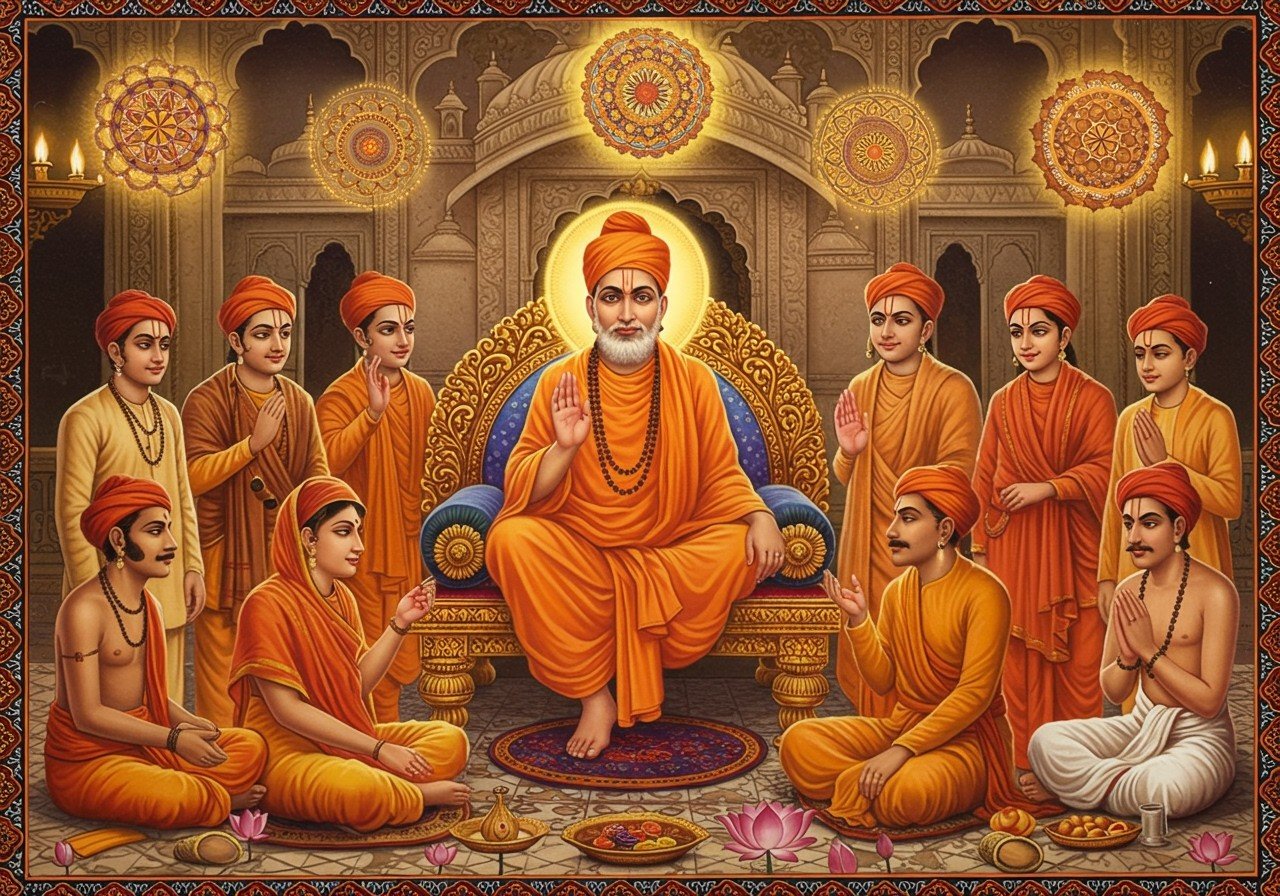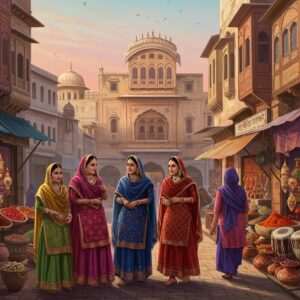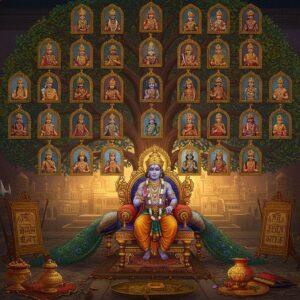
The Ramanandi Sampradaya holds a significant place in Hindu spiritual history. Established by the revered 14th-century saint Ramananda, this tradition championed devotion and equality. His teachings transcended caste boundaries, reshaping Northern India’s spiritual landscape. This exploration delves into the legacy of Ramananda and his followers, highlighting their enduring influence on Hindu practices.
Ramananda: The Founding Guru
A Journey of Spiritual Transformation
Ramananda’s life is a narrative of transformation and impact. Born into a traditional environment, he initially studied under Raghavananda. However, he eventually forged his own path, emphasizing Bhakti (devotion) as a core principle. He believed in making spiritual practices accessible to all, irrespective of social status. This revolutionary approach birthed the Ramanandi Sampradaya, a movement advocating spiritual equality and transcending societal divisions. His influence as a reformer continues to inspire subsequent Bhakti movements.
Key Figures in the Ramanandi Sampradaya
Carriers of a Shared Vision
Ramananda’s teachings were carried forward by his distinguished disciples. These individuals played pivotal roles in expanding the reach and influence of the Ramanandi Sampradaya. Let’s explore some of these key figures:
-
Tulsidas (1532-1623): A celebrated poet-saint and the composer of the epic Ramcharitmanas, a cornerstone text within the Ramanandi tradition. His literary masterpiece made the story of Rama accessible to a wider audience, solidifying its importance in devotional practices.
-
Kabir (1398-1518): A mystic poet and saint who championed the concept of a formless God, challenging prevailing religious and caste barriers. His emphasis on unity and direct experience of the divine resonated deeply within the Bhakti movement.
-
Ravidas (1377-1527): A revered Bhakti saint and disciple of Ramananda who also established the Ravidassia sect. His devotional songs and teachings highlighted social justice and equality, appealing to those marginalized by society.
-
Dhanna and Pipa: Immediate disciples of Ramananda whose hymns are enshrined in the Adi Granth, the sacred scripture of Sikhism. Their inclusion demonstrates the wide-ranging influence of Ramananda’s teachings across different religious traditions.
-
Sena and Maluk Das: Saints who founded sects directly originating from the Ramanandi lineage. They played a crucial role in disseminating Ramananda’s philosophy and establishing distinct branches within the broader tradition.
-
Nabha Dass (1537–1643): A prominent writer known for his hagiographical work, Bhaktamal, which chronicles the lives of various Bhakti saints. His writings documented the stories and teachings of these influential figures, including those within the Ramanandi Sampradaya.
These disciples, along with others, propagated the Ramanandi influence across India, shaping spiritual practices and fostering a sense of community among devotees. Their varied approaches contributed to the rich tapestry of the Bhakti movement.
The Enduring Relevance of the Ramanandi Sampradaya
A Living Legacy of Devotion
In contemporary times, the Ramanandi Sampradaya thrives as a vibrant expression of Hindu spiritual life. Ramananda’s timeless message of devotion and equality continues to resonate profoundly within modern society. His emphasis on social harmony remains a source of inspiration for many.
Spiritual and Cultural Contributions
Ramanandi practices are deeply woven into the fabric of Hindu festivals and communal gatherings. The Ramcharitmanas, penned by Tulsidas, remains a treasured scripture, guiding countless devotees on their spiritual paths. The devotional hymns of Kabir and Ravidas still reverberate in homes and temples, fostering a spirit of unity and inclusivity. You can find a wide selection of spiritual items, including idols and puja accessories, on Poojn.in.
Preserving Traditions, Embracing Change
Ramanandi communities across India actively preserve ancient traditions while engaging with contemporary challenges. Their dedication ensures the transmission of sacred rituals and teachings to future generations. Monasteries and pilgrimage sites serve as spiritual havens, offering spaces for contemplation and renewal. Explore a variety of holy cosmetics and food items to enhance your spiritual practices at Poojn.in and Poojn.in respectively.
Influence on Popular Culture
Ramananda’s legacy extends beyond religious observance. His teachings have influenced literature, music, and other forms of media, enriching India’s cultural heritage. Contemporary films and books frequently draw inspiration from the sampradaya, underscoring its continuing relevance in the modern world. Discover exquisite holy jewelry and utensils for your devotional needs at Poojn.in and Poojn.in respectively. For those seeking traditional herbal remedies, we offer a selection of Jaribooti products at Poojn.in.
The enduring influence of the Ramanandi Sampradaya stands as a testament to the power of devotion and the pursuit of equality. It serves as a beacon of hope, reminding us of the profound importance of unity amidst diversity. By honoring these traditions while embracing modern perspectives, we celebrate a legacy that enriches both our spiritual and cultural journeys.
Connecting with the Ramanandi Tradition through Poojn.in
At Poojn.in, we offer a curated selection of products to support your devotional practices within the Ramanandi tradition. Whether you’re seeking a beautiful Radha Krishna Bigraha (link), a sacred Shiva Lingam (link), or a murti of Adiyogi (link) or Lord Shiva (link), we have something to enhance your spiritual connection.
FAQs: Understanding the Ramanandi Sampradaya
Who is considered the founder of the Ramanandi Sampradaya? Ramananda, a 14th-century saint, is recognized as the founder of this influential tradition. His teachings emphasized devotion and accessibility to spiritual practices for all.
What are the core principles of the Ramanandi Sampradaya? Central to this tradition is Bhakti, or devotion, to Lord Rama. The teachings promote equality, transcending social barriers, and emphasize personal connection with the divine.
Who are some prominent figures associated with the Ramanandi Sampradaya? Beyond Ramananda himself, key figures include Tulsidas, the author of the Ramcharitmanas, Kabir, known for his mystical poetry, and Ravidas, celebrated for his devotional songs. These individuals, among others, contributed significantly to the growth and spread of the tradition.
What is the significance of the Ramcharitmanas? Composed by Tulsidas, the Ramcharitmanas is a revered text within the Ramanandi Sampradaya. It narrates the life of Lord Rama in a vernacular language, making it accessible to a wide audience and solidifying its importance in devotional practices.


